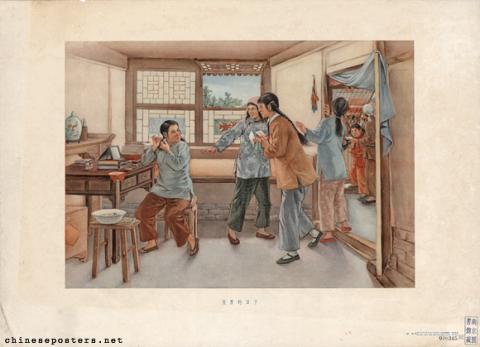 Sha Bing (1920-1979), formally known as Chen Shabing and originally named Chen Suping (陈素屏), was born in Wenzhou, Zhejiang Province. He grew up in a poor family. Smart since he was a child, he loved painting. At the age of 14, he learned painting beautiful women in the gongbi ("meticulous" 工笔) style. At the age of 18, he was a primary school art teacher. At the age of 20, he joined the woodcut research club founded by Ye Fu (野夫) and Jin Fengsun (金逢孙), and also studied woodcut. Soon, together with Yang Han, he founded the Woodcut News Agency and edited and published the semi-monthly Woodcut Newsletter (木刻通讯). During the Anti-Japanese War, he created woodcut works such as "Prostitutes and Politicians Under the Enemy" (在敌人盤踞下的妓女和政客) and "Singer in the New Era" (新时代的歌手), reflecting the people's suffering and resistance. His masterpiece "She Min Couple" (畲民夫妇) was included in the Selected Works of Woodcuts in the Eight Years of the Anti-Japanese War (抗战八年木刻选集) published by the Kaiming Bookstore in 1946. In the autumn of 1944, he was admitted to study art at Yingshi University. In 1946, he transferred to the Shanghai Academy of Fine Arts, organized the Progressive Student Movement there, and joined the Communist Party of China. At that time, the student movement was surging. He actively participated in the struggle and created comics such as "Public Servant Statue" (公仆塑像) and "Futility" (徒劳) to mock the authorities. After the victory of the Anti-Japanese War, he organized the Progressive New Art Painting Club in the urban area of Wenzhou, edited the "New Art Salon" (新艺沙龙), a supplement of the Zhe Ou Daily (浙瓯日报), and published a large number of woodcut works and articles against famine and against the civil war.
Sha Bing (1920-1979), formally known as Chen Shabing and originally named Chen Suping (陈素屏), was born in Wenzhou, Zhejiang Province. He grew up in a poor family. Smart since he was a child, he loved painting. At the age of 14, he learned painting beautiful women in the gongbi ("meticulous" 工笔) style. At the age of 18, he was a primary school art teacher. At the age of 20, he joined the woodcut research club founded by Ye Fu (野夫) and Jin Fengsun (金逢孙), and also studied woodcut. Soon, together with Yang Han, he founded the Woodcut News Agency and edited and published the semi-monthly Woodcut Newsletter (木刻通讯). During the Anti-Japanese War, he created woodcut works such as "Prostitutes and Politicians Under the Enemy" (在敌人盤踞下的妓女和政客) and "Singer in the New Era" (新时代的歌手), reflecting the people's suffering and resistance. His masterpiece "She Min Couple" (畲民夫妇) was included in the Selected Works of Woodcuts in the Eight Years of the Anti-Japanese War (抗战八年木刻选集) published by the Kaiming Bookstore in 1946. In the autumn of 1944, he was admitted to study art at Yingshi University. In 1946, he transferred to the Shanghai Academy of Fine Arts, organized the Progressive Student Movement there, and joined the Communist Party of China. At that time, the student movement was surging. He actively participated in the struggle and created comics such as "Public Servant Statue" (公仆塑像) and "Futility" (徒劳) to mock the authorities. After the victory of the Anti-Japanese War, he organized the Progressive New Art Painting Club in the urban area of Wenzhou, edited the "New Art Salon" (新艺沙龙), a supplement of the Zhe Ou Daily (浙瓯日报), and published a large number of woodcut works and articles against famine and against the civil war.
After the founding of the PRC, he served as the head of the Art Section of the Propaganda Department of the Wenzhou Prefectural Committee and participated in the preparations for the first Wenzhou Cultural Congress. In 1952, he transferred to the Beijing People's Fine Arts Publishing House and served as the deputy director of the creative office. His Chinese painting "Portrait of Female Militia" (女民兵造像) is collected by the Chinese Military History Museum. During the “anti-rightist” movement of 1957, he was incorrectly labeled as a “rightist” and was sent to the Wuhan Iron and Steel Company for labor reform. In 1968, he was sent to the Jiangling Seven May Cadre School to receive re-education. In 1970, he was sent to the Jiangling Embankment for reclamation work. Only in 1979, his "rightist" problem was corrected. Unfortunately, he died of illness in Wuhan on June 13 of that year at the age of 59.
Chen was the father of Chen Danqing (陈丹青, 1953), a Chinese-American artist, writer, and art critic. The younger Chen is well known for his realist paintings of Tibetans.
